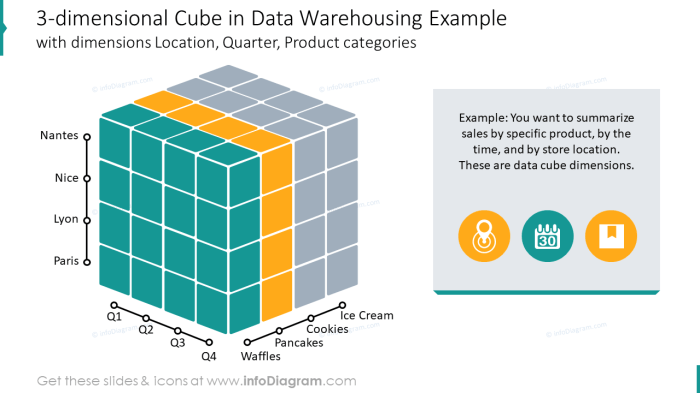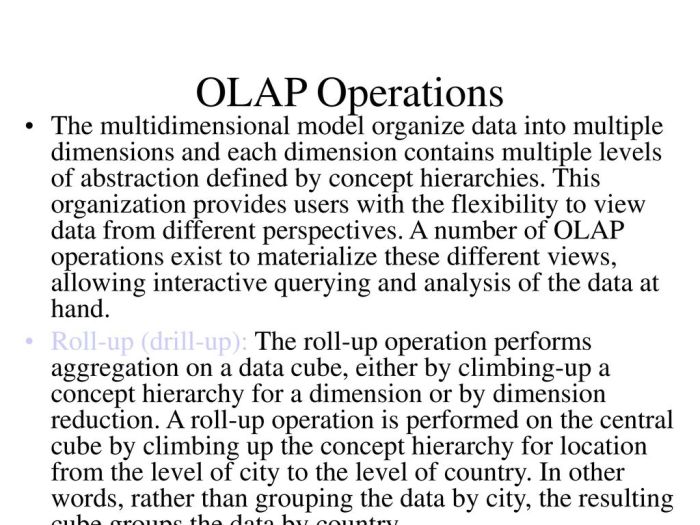Olap enables users to view data from different perspectives – OLAP, a cornerstone of modern data analytics, empowers users to transcend the limitations of traditional data exploration by enabling them to view data from multiple perspectives. This transformative technology unlocks a realm of possibilities for businesses and organizations, allowing them to derive deeper insights, make informed decisions, and gain a competitive edge.
OLAP’s unique architecture, centered around the concept of multidimensional cubes, provides a flexible and intuitive framework for data analysis. By slicing and dicing data along different dimensions, users can uncover hidden patterns, identify trends, and gain a comprehensive understanding of complex datasets.
Data Exploration with OLAP

OLAP (Online Analytical Processing) empowers users to explore data from multiple perspectives, providing a comprehensive view of their business operations. By organizing data into a multidimensional structure, OLAP enables users to analyze data across different dimensions and hierarchies.
For instance, a sales manager can explore sales data from the perspective of time, product, region, and customer. This allows them to identify trends, patterns, and relationships that might not be apparent when viewing the data from a single perspective.
OLAP Cube Structure, Olap enables users to view data from different perspectives
The core of OLAP is the OLAP cube, a multidimensional data structure that represents data in a hierarchical manner. The cube consists of dimensions (e.g., time, product, region) and measures (e.g., sales, revenue, profit). The intersections of the dimensions and measures form the cells of the cube, containing the actual data values.
The cube structure facilitates multidimensional data analysis by allowing users to view data from different angles and perspectives. For example, a user can analyze sales data by drilling down into specific time periods, products, or regions.
Data Slicing and Dicing
Data slicing and dicing are two fundamental operations in OLAP that enable users to manipulate and analyze data from different viewpoints.
- Slicing:Involves selecting a subset of data based on one or more dimensions. For instance, slicing sales data by time period would show sales for specific periods, such as months or quarters.
- Dicing:Involves creating a new dimension by combining existing dimensions. For example, dicing sales data by product category and region would create a new dimension that shows sales for each product category in each region.
Drill-Down and Roll-Up Operations
Drill-down and roll-up operations allow users to navigate data hierarchies and explore data at different levels of detail.
- Drill-Down:Allows users to move down the hierarchy of a dimension, viewing data at a more granular level. For example, drilling down on sales data by time period could show sales for specific days or weeks.
- Roll-Up:Allows users to move up the hierarchy of a dimension, viewing data at a more aggregated level. For example, rolling up sales data by time period could show sales for months or quarters.
OLAP Tools and Applications
Numerous OLAP tools and applications are available to help users explore and analyze data from multiple perspectives.
- Microsoft Power BI:A popular OLAP tool that offers a comprehensive set of features for data exploration, visualization, and analysis.
- Tableau:Another widely used OLAP tool that specializes in data visualization and interactive dashboards.
- IBM Cognos Analytics:A powerful OLAP platform that provides advanced analytics capabilities, including predictive modeling and machine learning.
OLAP tools are widely used in various industries and domains, including finance, retail, healthcare, and manufacturing, to gain insights into business operations and make informed decisions.
FAQ Section: Olap Enables Users To View Data From Different Perspectives
What are the key benefits of using OLAP?
OLAP offers numerous benefits, including multidimensional data exploration, fast data retrieval, support for complex analytical operations, and enhanced decision-making capabilities.
How does OLAP differ from traditional data analysis methods?
OLAP employs a multidimensional data model, enabling users to analyze data from multiple perspectives simultaneously. Traditional data analysis methods typically work with flat, two-dimensional datasets.
What types of organizations can benefit from using OLAP?
OLAP is suitable for organizations of all sizes and industries that require advanced data analysis capabilities. It is particularly valuable for businesses dealing with large and complex datasets.

